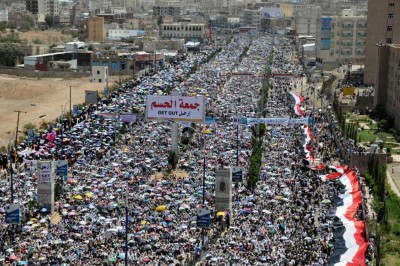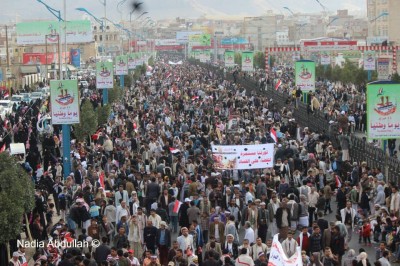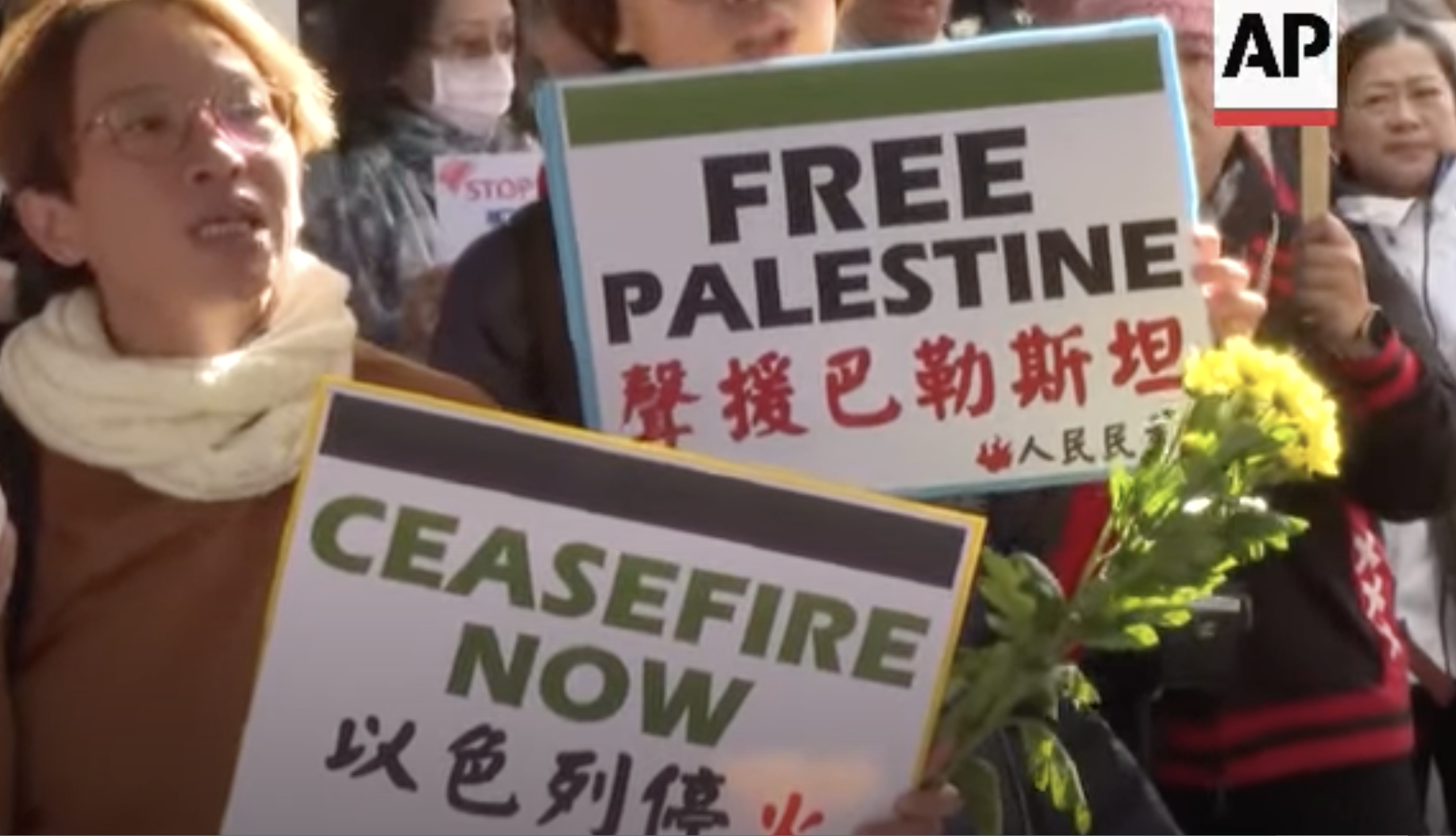February 11th marked the third anniversary of Yemen's revolution which toppled former President Ali Abdullah's Saleh's 33 year rule. Just a day before, on February 10, Yemen's president Abdu Rabu Mansour, based on the National Dialogue‘s recommendation for the political transition and after deliberating with a Region Defining Committee, approved turning the country into a six-region federation state.
Nadia Al-Sakkaf, an activist, member of the National Dialogue and editor-in-chief of The Yemen Times, tweeted:
Just came out from #NDC's Presidential Regions Defining Committee. It's decided! #Federal Republic of #Yemen will be six regions!!
— Nadia Sakkaf (@NadiaSakkaf) February 2, 2014
The federal system was a solution to counter the failure of the centralized government and to give the south more autonomy while preserving Yemen's unity. Yemen's parties had been divided on whether to split the federation into two or six regions. A north-south divide which was suggested by Southerners was rejected due to fear that it could set the stage for the south to secede. The six agreed regions included four in the north, comprising Azal, Saba, Janad and Tihama, and two in the south, Aden and Hadhramaut.
Azal includes the capital Sanaa, which will be a federal city not subject to any regional authority, in addition to the provinces of Dhamar, Amran and Saada. Aden would comprise the capital of the former south, as well as Abyan, Lahej and Daleh. The southeastern Hadhramaut province would include Al-Mahra, Shabwa and the island of Socotra, while Saba comprises Bayda, Marib and Al-Jawf. Janad would include Taez and Ibb, and Tahama also takes in Hudaydah, Rima, Mahwit and Hajja.
Yemen_updates tweeted a link showing the new regions:
#Yemen's new federal map- English pic.twitter.com/n4OWD0XnIz
— Yemen Updates (@yemen_updates) February 10, 2014
There were many reactions among Yemenis and Arabs both for and against this decision.
Yemeni youth activist, Jamal Badr jokingly tweeted a still shot from a scene of a famous Egyptian comic play:
المهم مش #اليمن بخير … #سعيد_صالح :D pic.twitter.com/XU1bG59rN5
— Jamal Badr (@JamalBadr) February 11, 2014
Isn't Yemen fine?? Yes, every region is fine but separate
Farea Almuslimi disapproving the haste in the decision making tweeted:
استغرق والدي واعمامي تقسيم الارض التي وروثوها من جدي ( القليلة جدا) وقت وتفكير اكثر واطول من الذي استخدم لتحديد شكل وعدد الاقاليم في #اليمن
— Farea Al-muslimi (@almuslimi) February 11, 2014
It took my father and uncles a longer and more thoughtful time to divide the (small) land they inherited from my grandfather then it took to determine the form and number of the regions in Yemen
Egyptian visual artist and film maker, Mahmud Abdel Kader, commented:
محدش بيقول إن الإمارات متقسمة لإنها فيدرالية … ده عشان فكرة الفيدرالية انها تجمع مش تقسم
اللى حصل فى اليمن تقسيم مش تجميع
— عبقادر (@MKadr) February 11, 2014
Nobody is saying that the UAE is divided because it is federal … because the idea of federalism is to add not divide, what happened in Yemen is a division not an addition
Lebanese Karl Sharro sarcastically tweeted:
Yemen has just become a federal republic of six regions. Amateurs. Lebanon is a federal republic of four million regions.
— Karl Sharro (@KarlreMarks) February 10, 2014
Yet there were many questions in people's minds, which Sam Waddah raised on Facebook:
Major question marks remain on dividing power, authority, duties between regions and central state, defining the new system, how local governments will be elected, etc. Tentatively federal system is a good one but it's too early to tell here and by leaving these issues undefined I think Hadi and the regions defining committee are putting the cart before the horse!
Adam Baron also wondered:
Main issue isn’t what #yemen’s federal regions are but what they will do. Divisions of powers/governance duties in new system still unclear.
— Adam Baron (@adammbaron) February 10, 2014
Nadia Al-Sakkaf shed some light on the new federal system in her article in The Yemen Times:
The relationship between the regions and the federal government will be written into the constitution. The details will be defined in a Federal Regions Law after the constitution has been approved via a national referendum, expected to take place three months after the creation of the Constitutional Drafting Committee. Each region will have the autonomy to devise its own regional laws to define the relationship among its various states.
Three years after the revolution, on February 11, Yemenis were back on the streets but for various reasons. There were those who went out to celebrate the anniversary of a revolution which awed the world with its power and peacefulness and there were those who went out to protest against the government's corruption and for not realizing the revolution's demands.
Majda Al-Hadad, an activist spearheading the campaign against the government's continuous electricity power cuts tweeted:
لاحاجة لان اعدد اسباب خروجي غدا, فلايوجد ماهو ايجابي ليجعلني اتردد. لاحفوف لاكرامة لاقانون لاعدل ولا وجود للحكومة الا بالفساد والظلم.#اليمن
— Majda Al-haddad (@meMajda) February 10, 2014
It is not necessary for me to list the reasons for me to go out tomorrow, there is nothing positive that would make me hesitate. No rights, no dignity, no law, no justice, and no presence of the government except corruption and injustice.
Journalist Khaled Al-Hammadi tweeted:
3rd. anniv. of #Yemen revolution marked with 3 rallies in #Sanaa 1st anti govt 2nd anti public prosecutor & 3rd anti keeping youth in prison
— Khaled al-Hammadi (@KhaledHammadi) February 11, 2014
“The people want to topple corruption“, “the people want the fall of the government“, “a new revolution all over again“, “oh government of corruption, leave the country” chanted protesters across the streets of Sanaa.
(Video posted on YouTube by Ridan Bahran
Akram Alodini also highlighted the political division in his tweet:
الصباح المظاهرات لجمهورية السبعين والاستاذ الرياضي,بعد العصر لجمهورية الستين، والمواطن في #اليمن لاحول له ولاقوة pic.twitter.com/XCvsI1skFq
— اكرم احمد العديني (@AkramAlodini) February 11, 2014
In the morning, marches for the republic of Sabeen and the sport stadium, and in the afternoon for the republic of Seteen, and the citizen is helpless
Lawyer Haykal Bafanaa wondered how would corrupt politicians counter corruption:
How is corruption to be tackled in #Yemen by politicians, when all political parties and actors are equally tainted?
— هيكل بافنع (@BaFana3) February 12, 2014
Researcher, blogger and activist Atiaf Al-Wazir tweeted:
@supportYemen's 1st video on #Yemen's revolution made in Sept 2011 http://t.co/eL8rhIyXq3 – same demands continue. #Yemen
— Atiaf Alwazir (@WomanfromYemen) February 11, 2014
This video by SupportYemen is a reminder of what the revolution was about and what it still needs to achieve:
And as Rooj Al-Wazir, tweeted, some of the revolutionary youth, three years later, were still behind bars:
Dozens of revolutionary youth still behind bars on 3rd anniversary of #Yemen’s uprising http://t.co/E2cT6t5tWa via @theyementimes
— Rooj (@Rooj129) February 11, 2014
Journalist Benjamin Wiacek tweeted with disappointment, a bitter sentiment shared by many of the revolutionary youth:
3 years ago we had faith, hope and we were walking towards change… That was 3 years ago… #Yemen #revolution #statusquo #depressed
— Benjamin Wiacek (@Nefermaat) February 11, 2014
Journalist Iona Craig, who has been living in Yemen since 2011, and as the rest of Yemenis has been suffering from frequent and lengthy electricity cuts tweeted:
On the 3rd anniversary of #Yemen's revolution probably the most fitting reminder of 2011 is the current power cut. #nothingchanges
— Iona Craig أيونا (@ionacraig) February 11, 2014
Many Yemenis did not feel a change in their daily living conditions – quite the contrary, many were disappointed and frustrated with its deterioration. In a question posed on Facebook by journalist Ahmed Ghurab, “In your opinion what change has occurred in the living conditions of the average citizen in the last three years since the outbreak of the revolution?!!”, the majority complained about the hike in prices, the continuous power outages, the insecurity and instability along with the increase of assassinations, the car explosions and kidnappings and the failure of the government to address or manage these issues.
Nevertheless, there were those who were celebrating the revolution's achievements so far and were still hoping for more. Photos of the marches all over Yemen commemorating the third anniversary of the start of the revolution were posted all over Twitter and Facebook.
3rd Anniversary. #arabspring #February11 #yemen pic.twitter.com/3DxCLgKyjZ
— Anwar Muthana (@anwarmuthana) February 12, 2014
Yemen-based journalist Adam Baron tweeted:
At the thawra 2.0 protest. Haven't seen change square this crowded since 2011. #yemen
— Adam Baron (@adammbaron) February 11, 2014

A photo from the Friday marches in Sanaa in 2011 demanding the fall of former president Ali Abdullah Saleh
Activist, photographer and member of the National Dialogue, Nadia Abdullah,posted photos of the marches in Sanaa on facebook.

Marches in Sanaa's Seteen street celebrating the 3rd anniversary of Yemen's revolution (Photo by Nadia Abdullah)
On a more positive note, Baraa Shiban, a youth activist and also member of the National Dialogue, tweeted:
The Youth Peaceful Revolution like a dream came true #Yemen's revolution anniversary
— Baraa Shiban (@BShtwtr) February 11, 2014
He summarized in his Facebook post, what many would undoubtedly agree is the greatest achievement of Yemen's revolution:
Yemen has a new generation of men and women who believe in the principals of democracy and human rights. Yemen's youth now believe in equal citizenship, women's rights and minorities. Yemen's youth today believe in achieving their demands by following the peaceful method.
The revolution continues…







2 comments
Federalism is the most appropriate solution for Yemen and Yemenis, especially in the current circumstances and I think that the consensus on the piece either rejects the idea of the Federation and the Federal Nhbo are those who have the wealth of the people